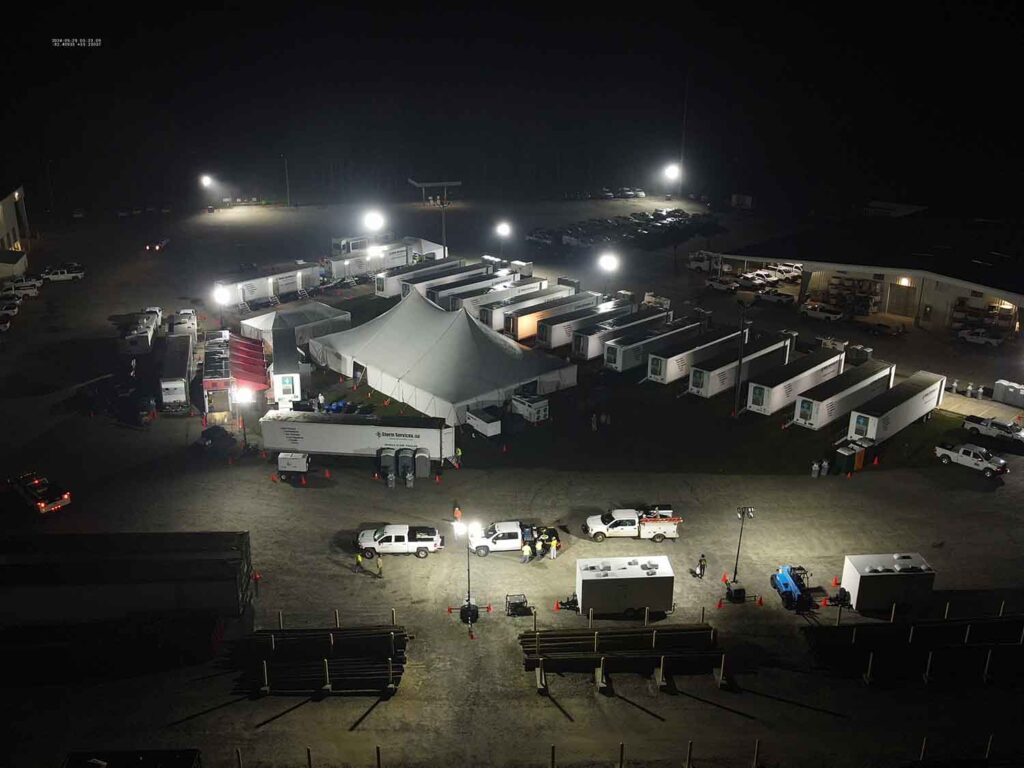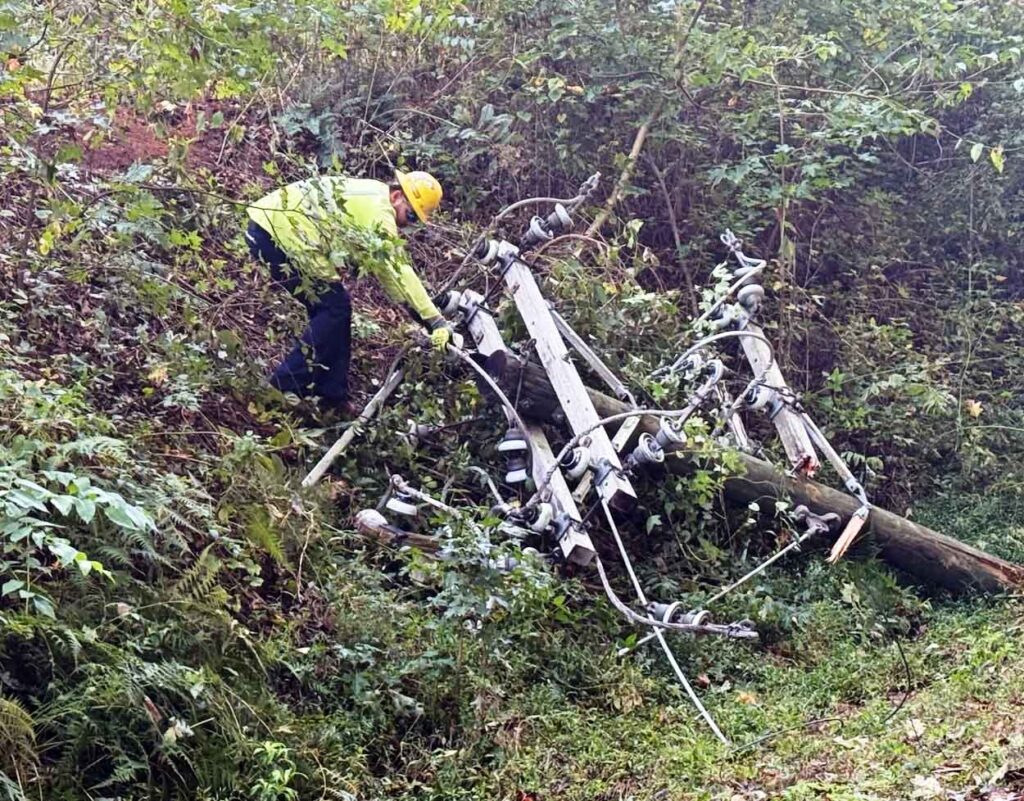
Day 7 Update
Thursday, Oct. 3, 4:30 p.m. ET
Nearly a week into the most sweeping storm in their history, electric cooperatives had made impressive progress in reducing the number of outages from 1.25 million to less than 302,000, enabling them to concentrate on the toughest remaining situations in Georgia and the Carolinas.
Outages in Georgia numbered about 151,000 as of late afternoon Thursday, with problem spots in the southeastern, south-central and eastern parts of the state. In South Carolina, the number stood at 76,000, mostly in the north and west, while North Carolina had 63,300, almost all of which were at co-ops bordering Virginia, Tennessee and South Carolina.
“While Tropical Storm Helene brought her worst, the unity and helping spirit that we are seeing in western North Carolina represents our best,” said Nelle Hotchkiss, senior vice president and chief operating officer for North Carolina’s Electric Cooperatives. “We are resilient, we are strong, and we are in this together.”
In an unprecedented display of mobilization and cooperation, mutual aid crews from as far away as Minnesota and Kansas were trucking to the disaster scenes as co-ops started to rotate lineworkers after several days of exhausting but rewarding work.
Among co-ops in Florida, where Hurricane Helene first struck, Tri-County Electric Cooperative, based in Madison, had about 4,400 outages by Thursday afternoon. The restoration effort was ongoing, but impressive considering the co-op reported 923 broken poles, 259 broken crossarms and 69 bad transformers. Chiefland-based Central Florida Electric Cooperative and Live Oak-based Suwannee Valley Electric Cooperative were both closing in on less than 1,000 outages.
Day 6 Update
Wednesday, Oct. 2, 10:30 a.m. ET
As of late morning Wednesday, diligent, painstaking work by line crews from 19 states had restored power to approximately 825,000 electric cooperative meters left in the dark by Hurricane Helene. In particular, Florida co-ops were down to about 22,000 outages from a high of more than 200,000.
Much work remained, however. North Carolina co-ops had about 86,000 remaining outages as lineworkers from 30 electric co-ops in the state and nine other states combated washed-out roads and wretched conditions to relieve systems near the Tennessee and Virginia borders.
“We are finding more destruction and houses that have been damaged beyond repair. We’ve experienced many floods in Haywood EMC’s 85-year history, but what we are currently finding is absolutely unprecedented,” said Mitch Bearden, chief communications officer at the Waynesville, North Carolina-based co-op, which had about 10,000 outages Wednesday.
“Currently, I am unsure of a number of homes or businesses that may be forever gone due to these storms across our service area. We know that there are many and are hopeful we can play any part in being there for these folks who have lost everything. Some of these people are also our employees,” Bearden said.
Georgia co-ops reported nearly 169,000 outages, down from about 435,000, while South Carolina outages stood at about 111,000.
“We’ve been hit harder than we could ever imagine,” said Chad Stone, interim CEO at Little River Electric Cooperative, said in a video message. The Abbeville, South Carolina-based co-op lost 99% of power to its 15,000 meters and still had about 10,000 down on Wednesday. “At this time, we’re looking at a few more weeks, but we’re working as hard as we can to get everybody in as soon as possible.”
Day 5 Update
Tuesday, Oct. 1, 5 p.m. ET
Yes, that was the president and CEO of Broad River Electric Cooperative fixing hot dogs and packing lunches for lineworkers laboring to restore power to members of the South Carolina cooperative.

In fact, Terry Mallard was undertaking more than kitchen duty for crews at the Cowpens-based cooperative, which saw major parts of its system darkened by Hurricane Helene.
“I also caught him washing the dishes after breakfast yesterday morning and taking out the trash. He has set a real example of service over the past several days,” said Clary W. Phillips, vice president of member services.
It was one small example of an all-hands-on-deck approach taken by electric cooperatives as work on the devastation from Helene entered its fifth day—the first day of National Co-op Month. Regardless of role or responsibility, co-op personnel say they are doing what needs to be done, even amid personal and property loss at home.
“We’ve also had our staff make sandwiches and pack lunch bags with snacks and fruit for the linemen to take with them as they head out every morning,” Phillips added.
Employees at Jefferson Energy Cooperative in Wrens, Georgia, were doing everything they could to comfort an army of lineworkers housed in a trailer city while working to bring more than 24,000 members online as of midday Tuesday.
“We are making signs that will hang on the fence and gates thanking them, and we put up TVs in the tent and turned on sports so that they can unwind,” said Teresa Lampkin, director of cooperative communications. “We’re kept a fun spirit, played music and danced through the day. We’re doing all we can to smile and keep smiles on their faces.”

Restoration work was nearing its final stages Tuesday in parts of Florida, where about 37,000 outages remained. Hard-hit Suwannee Valley Electric Cooperative estimated 95% of its members would have power by 11:59 p.m. Thursday, thanks to a complement of nearly 1,500 workers at its basecamp.
Georgia co-ops had about 191,000 outstanding outages, with 144,473 in South Carolina and a little more than 100,000 in North Carolina.
“We’ve never seen something like this in some of these electric co-op service territories,” NRECA CEO Jim Matheson said during a Tuesday news conference. “While this disaster affected communities across the Southeast, electric cooperatives serve the more remote, more rugged and more difficult-to-restore locations.”
Bronson Bragdon, director of marketing and communications at Excelsior EMC, said the mood is upbeat at the Metter, Georgia-based co-op, even though its system was totally down after the hurricane struck. About 15,000 outages remained Tuesday as more than more than 300 lineworkers joined the co-op’s 25-member line team.
“In the midst of such a gloomy scene, it’s reassuring to see such compassion for one another,” he said. “We are also very grateful that all of our employees and their families are safe. While some have experienced damage to their homes and almost all are still without power (yes, even EEMC employees experience outages), it’s all repairable.”
Still, there was no doubting the gravity of the challenge left by the storm, which left a death toll of at least 130, with many still unaccounted for in flood-ravaged areas of North Carolina. Co-ops from 18 states have sent mutual aid crews to the seven states affected by Helene.
Tom Batchelor, CEO of Haywood EMC in Waynesville, said an “all-out effort” has restored power to 11,000 members, but nearly 15,000 outages remain. Flooding and landslides have swept away roads, limiting access to infrastructure and isolated communities.
“For our own co-op lineworkers, they’re frequently coming to restore power during the day, and going home to a home that has no electricity,” said Mike Couick, CEO of the Electric Cooperatives of South Carolina.
Laurens Electric Cooperative in Laurens, South Carolina, had more than 32,000 meters without power on Tuesday, a little more than half of its total. Many of those will have to wait while Duke Energy repairs major damage to its transmission infrastructure, which carries electricity to a major part of the co-op. Duke estimated transmission might be out until Monday.

“When you have the majority of the transmission service in the upstate offline and then you couple that with here at the co-op well over 200 broken poles downed and hundreds of miles of down circuits, that type of catastrophe takes time to rebuild and replace,” said Laurens Electric spokesperson Jim Donahoo.
Gary Stooksbury, CEO of Aiken Electric Cooperative, said a tent city for 500 lineworkers should be up and running by Wednesday to help with the Aiken-based co-op’s system, about half of which lacked power.
“This is going to be several weeks because of the sheer devastation we have on our system,” he said in a message to members.
The Cooperative Development Foundation (CDF) has set up a dedicated page for donations to raise funds for disaster relief to electric cooperatives and co-op employees directly affected by Hurricane Helene.
Steven Johnson is a contributing writer for NRECA.
Earlier Coverage of Hurricane Helene:
Day 1 | Day 2 | Day 3 | Day 4 | Photos from the Co-op Response